AMD's 65nm Brisbane Core Previewed: The most energy efficient AMD CPU to date
by Anand Lal Shimpi on December 14, 2006 6:08 PM EST- Posted in
- CPUs
Gaming Performance & Power Usage
By and large the biggest contributor to power consumption when running 3D games is going to be your graphics card, and in this case it's the 8800 GTX plugged into our test bed. That being said, there is still a fairly sizable difference between the CPUs in power consumption; we're simply dealing with much higher numbers than before thanks to the GPU running at full load.
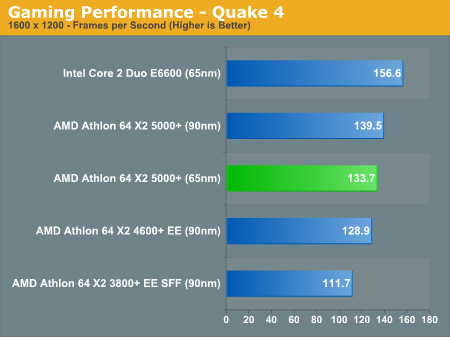
Core 2 is significantly faster than the X2 in Quake 4, which we've seen in previous comparisons. We ran into a strange anomaly with gaming performance and our Brisbane chip; for some reason, in Quake 4 and Half Life 2, the 65nm 5000+ ended up being slightly slower than its 90nm counterpart. We're still waiting for an answer from AMD, but as far as we know there shouldn't be any performance differences between the two chips.
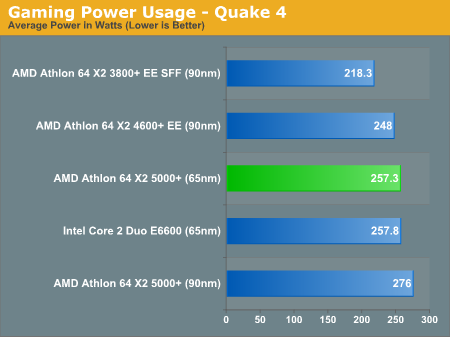
Power consumption is basically equal between the Brisbane 5000+ and the Core 2 Duo E6600, but given that the latter performs so much better Intel gets the overall win in power efficiency:

Switching games doesn't change the rankings at all, as Oblivion gives us a repeat of what we saw in Quake 4. Interestingly enough, we didn't see a performance difference between the 90nm and 65nm 5000+ offerings here like we did in Quake 4.
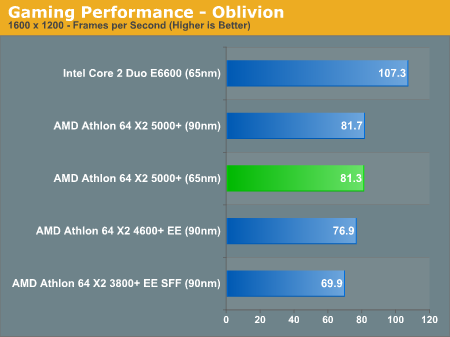
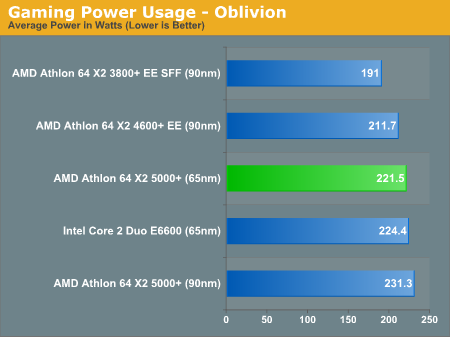
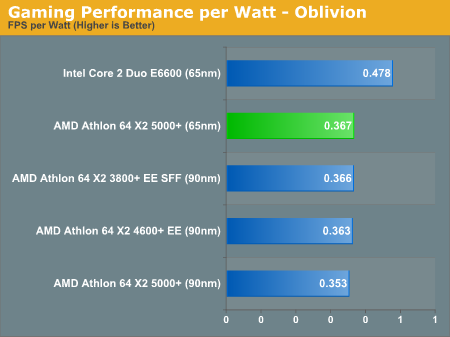










63 Comments
View All Comments
dev0lution - Friday, December 15, 2006 - link
Now that both companies claim to offer "platforms" it'd be interesting to see an Intel 965 board vs. an ATI board being used in these benches. Not sure that the NVIDIA models were the best choice here, especially since their not apples to apples on generation and power consumption.poohbear - Thursday, December 14, 2006 - link
im quite shocked to see the gaming performance advantage @ 1600x1200!!!! is'nt the cpu removed as a performance bottle neck @ such a high resolution? its all about the gpu horsepower @ that resolution no? can't believe a cpu can show a 25fps diff @ 1600x1200?!?!?JumpingJack - Friday, December 15, 2006 - link
Some more research here is in order. The G80 GPU, commonly known as the 8800 GTX or GTS on the market, has taken graphics performance to a new level. All of the reviews that used an AMD FX-60 or 62 CPU clearly showed throttling back to the CPU in many if not most cases, only at the highest possible resolutions/AA + FSAA did the scaling turn back on with an FX-60. The X6800 released the full potential of this card.
The difference in framerate you see bettweent he 5000+ and the E6600 is that the E6600 is has pushed the bottleneck further ahead -- simply because the E6600 is a better gaming CPU.
Tom's did a good article titled: The 8800 Needs the Fasted CPU.
In essense, even for a single card solution, an AMD CPU is not a good match for this card.
Makaveli - Friday, December 15, 2006 - link
The reason for the 25fps difference must mean the Geforce is more cpu bottlenecked on the AMD platform than the intel one.U gotta remember the 8800GTX is an insanely fast card, and is still bottlenecked on Conroe systems.
JarredWalton - Friday, December 15, 2006 - link
This is why back at the Core 2 Duo launch we talked about CPU performance using games running at 1280x1024 0xAA. When a faster GPU comes out and shifts the bottleneck to the CPU (as has happened with the 8800 GTX), saying "Athlon X2 and Core 2 Duo are equal when it comes to gaming" is a complete fabrication. It's not unreasonable to think that there will be other games where that ~25% performance difference means you can enable high quality mode. Company of Heroes is another good example of a game that can chug on X2 chips at times, even with high-end GPUs.XMan - Thursday, December 14, 2006 - link
Do you think you might have gotten a higher overclock if you weren't running HTT at 1125MHz?!?Sunrise089 - Thursday, December 14, 2006 - link
The chart on page one claims to have pricing info. There is none as far as I can see.JarredWalton - Friday, December 15, 2006 - link
Fixed. :)RichUK - Thursday, December 14, 2006 - link
Same old sh!t. It's nice to see AMD finally kicking off their 65nm retail chips, but lets see this new core for God sakes.They're lacking big time, this really is sad. **Thumbs-Down**
Stereodude - Thursday, December 14, 2006 - link
How's a chip that uses less power run hotter? On the last page the 65nm X2 5000+ hit 51C under load, lower than any other chip, but it uses more power than any chip except the 90nm X2 5000+. How's that work?